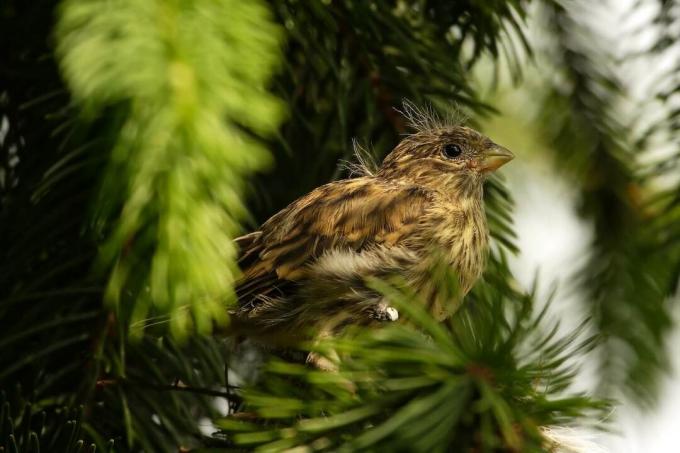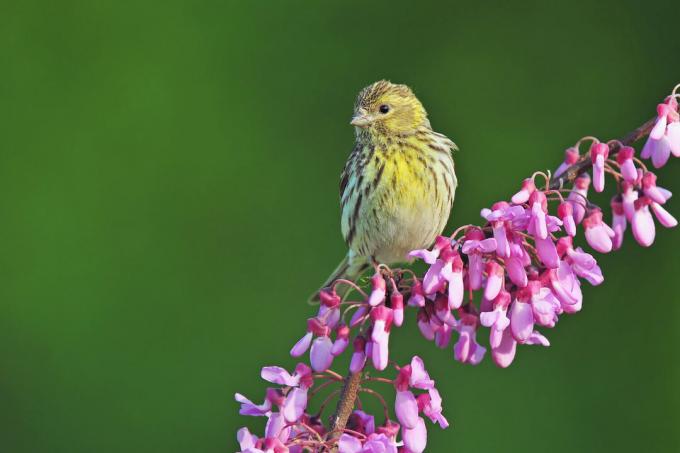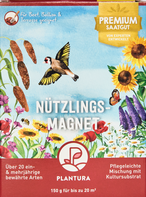What do female serins look like? Where does it live and what does the bird eat? We have all the important information and pictures about this special finch.

The Girlitz (Serinus serinus) is our smallest native finch. That's why he is far from inconspicuous. With its lemon-yellow plumage and high-pitched, jangling song, the serin is indeed a small gem among songbirds. It has been known for these properties since antiquity and has always been kept in aristocratic circles as a cage bird. He was not replaced until the 15th Century, when the Canary Girlitz (Serinus canaria) was brought to the mainland from the Canary Islands. From this, the various canaries were later bred. Nevertheless, the girlitz is still kept as a cage bird today, even though bird trapping is of course strictly forbidden in Germany. You can find more exciting facts and pictures in our profile below.
contents
- Girlitz: A detailed profile
-
How to recognize the girlitz
- What does Girlitz singing sound like?
- How do you recognize the girlitz juveniles?
- How do you recognize the eggs of the serin?
- What is the difference between female and male serins?
- Which habitat does the Girlitz prefer?
- Where does he build his nest?
- When does the serin breed?
- Where does the little finch spend the winter?
-
Support the Girlitz: That's how it works
- What does the girlitz eat?
- Which nesting aids are suitable for the yellow finch?
- How can you additionally support the girlitz?
Girlitz: A detailed profile
| size | About 11 - 12 cm |
| Weight | About 11-13g |
| breeding season | April June |
| lifespan | About 5 years |
| habitat | parks and gardens |
| food | Fine seeds, leaf and flower buds |
| threats | Lack of habitat, trapping birds for sale |
How to recognize the girlitz
The Girlitz can be easily recognized both by its penetrating song and by its colorful plumage. The bird is notable for its small size and tiny, triangular finch beak. The back and elytra are heavily striped grey-yellow. The gray cheeks are framed by bright yellow lines and the head is crowned by a yellow forehead. The yellow color continues over the chest and abdomen and ends in white flanks. In flight, the serin can also be recognized by its lemon-yellow underside – also known as the rump.
The Girlitz in the field is actually only confused with the yellowhammer. However, this is significantly larger and is characterized by an almost completely yellow head and a reddish-brown breast in the breeding plumage.

What does Girlitz singing sound like?
The girlitz has a very special and easily recognizable bird's voice. His vocals are high, wild, and jangling, and consist of an unstructured, fast, and cohesive verse. The voice is a little reminiscent of the squeaking of unoiled gears.
This is how the song of the girlitz sounds:
How do you recognize the girlitz juveniles?
Young serins are slightly better camouflaged than their parents and are therefore harder to spot. They still lack the bright yellow color that characterizes this species. The plumage of the young birds has a beige to off-white basic color and is streaked with strong, grey-brown stripes.
How do you recognize the eggs of the serin?
The female serin lays three to five eggs per season in a cup-shaped nest made of grass, leaves, moss and other fine plant parts. The inside of the nest is carefully padded with lots of feathers and animal hair. The eggs themselves are between 15 and 18 millimeters in size, pale blue or green in color and dotted with brownish-red spots.
What is the difference between female and male serins?
As is so often the case in nature, the male serins are a bit more conspicuous than their partners. While the male is adorned with sulphurous yellow elements, the female exhibits somewhat duller, greenish-yellow patterns. Also, her chest is streaked with dark lines, while her partner presents a pure bright yellow breast.

Which habitat does the Girlitz prefer?
Girlitz love semi-open landscapes with isolated trees and high bushes, which they can use as hiding places and nesting sites as well as singing stations. They look for their food mainly on the ground. Wild meadows with seed-bearing wild herbs are particularly popular. But the girlitz has also adapted to urban landscapes and is therefore not uncommon in parks, gardens or on the outskirts of town.
Where does he build his nest?
The girlitz only builds its nest after a careful selection of the breeding site. This should be as well hidden as possible in a dense, high bush or tree, but at the same time a good one Offer a view and a singing station from which the males mark their territory with impressive song performances can. The female takes over the task of building the nest.
When does the serin breed?
The breeding season of the serin extends from April to June. During this time, males and females remain strictly loyal to each other and can raise up to two broods. After laying the eggs, female girlitz incubates her eggs for about two weeks, while the male guards and defends her and the common nest. After hatching, the young are fed by both parents with a mixture of pre-soaked, fine seeds and protein-rich small insects such as aphids and caterpillars. After 16 to 17 days, the young are so far developed that they leave the nest on their own and explore the surroundings. They are then supported by their parents in their search for food for a few days before they devote themselves to a possible second brood. Then the little ones are on their own.

Where does the little finch spend the winter?
The majority of our German serins escape their uncomfortable breeding grounds in the cold winter months and head to the western Mediterranean. However, since they do not have to travel very long distances, the last birds do not move into their winter quarters until November and are already with us again from March.
Support the Girlitz: That's how it works
If you want to set up a small living space for the girlitz in your own home, you must first understand what the little bird needs for a home. In the following sections, you will learn how you can help the Serin with foraging, nest building and even grooming.

What does the girlitz eat?
Girlitz feed mainly on fine seeds. These can come from a variety of wild herbs, which you can find in our special article on the topic "herbs for birds“ get to know. However, they also use flower and leaf buds in spring and smaller insects to raise their young. If you would like to offer the finches additional food, you should stick to the natural diet as much as possible. A grain feed with sunflower seeds and finer wild herb seeds is well suited. Note, however, that most native serins spend the winter farther south and are therefore rarely seen at snowy bird feeders.
With our Plantura all-season feed you can also support the garden birds in summer and during the breeding season. The protein-rich food with extra lime is ideal for expectant bird parents.

Plantura year-round food for wild birds
High-protein year-round bird food
for all grain and soft feed eaters,
supports bird parents & their offspring
Which nesting aids are suitable for the yellow finch?
As a free-breeding bird, the serin cannot be impressed with a classic nesting box. Such structures are more for cave breeders like blue tits or starlings suitable. Instead, the little finch appreciates more natural breeding opportunities. In your garden, make sure that hedges and treetops are not thinned out too much to give the girlitz good hiding places for its nest.
How can you additionally support the girlitz?
Especially in the breeding season and for the rearing of young birds, the serin is dependent on protein-rich insects in addition to seeds. Like many other songbirds, the yellow finch is therefore suffering from the ongoing loss of insects. Ours can help Plantura beneficial insect magnet, with the help of which you can create an insect paradise in your own garden. With this you can not only make the girlitz happy, but also bring a lot of useful pollinators and pest controllers into your garden.

Plantura beneficial insect magnet
Annual & perennial species for beneficial insects
such as birds, bees & Co, easier to care for
Blossom dream in bed, pot & window box
A favorite pastime of the girlitz on hot days is also bathing. In small puddles, the little birds can often be seen grooming themselves. A bird bath can also be easily made from a flat bowl or a large trivet, which conveniently also doubles as a drinking trough.
But be careful: regularly let a birdbath or drinking trough dry out completely or change the water and clean the bowl. Because such meeting places for birds can quickly become contaminated and lead to the transmission of infectious diseases. The risk of infection increases, especially at high temperatures, which is why it is best to clean a bird bath every day on hot days.

All garden birds appreciate a little help in their daily struggle for food and other resources. If you want to find out more about our feathered friends, take a look at our other species portraits and learn about them, for example barn swallow know something better.
...and receive concentrated plant knowledge and inspiration directly in your e-mail inbox every Sunday!



